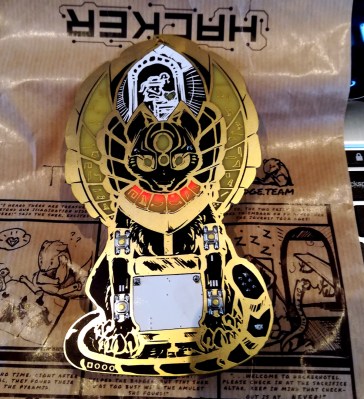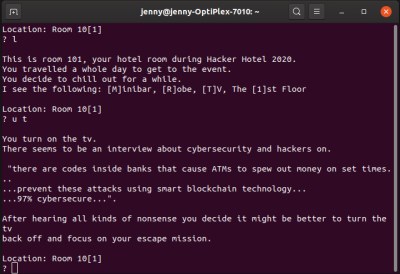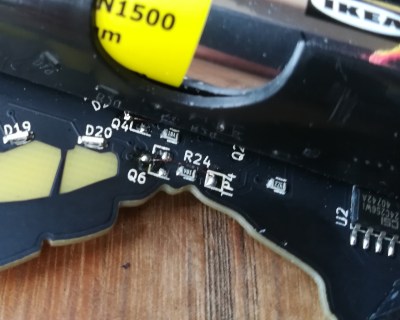The art of the electronic conference badge has evolved over the last decade or more, such that for an individual example to be of note it now has to include some exceptional features. Perhaps a function that might previously have been considered impossible in a badge, or maybe an unusually beautiful design, an entertaining and compelling functionality, or it simply pushes the capabilities of an otherwise limited device in an unusually ingenious way. The badge from the recent Hacker Hotel 2020 comes from the same badge team that created the software platform derived from the SHA 2017 badge, and it ticks many of these boxes by combining a genuine work of art with a set of delightfully intricate puzzles at enough levels to interest all participants in the event.
Exquisite Artwork For An Ancient-Egyptian-Themed Puzzle

The badge arrived packaged in a paper bag with a cartoon strip on the outside setting the scene for the device’s puzzles. The badge.team badger and python head to Egypt, where they become trapped in a pyramid, and the badge puzzles are there to free them. Pulling it out of the bag reveals a matte black and Electroless Nickel Immersion Gold (ENIG) board about 140 mm (5.5″) by 80 mm(3.2″) with artwork from the badge.team designer Nikolett featuring an ancient Egyptian styled cat – representing the god Bastet – surrounded by an array of clear FR4 panels. There’s also a lanyard with hieroglyphic text, and a cheap pair of earbud headphones. The badge makes extensive use of clear FR4 with LEDs behind it to provide diffuse light.
Turning it over, most of the middle of the board is taken up by a pair of AA cell holders with the surface-mount microcontroller just visible beneath them. At the bottom of the board is a 3.5 mm headphone connector, to its right are PSU components with a power switch and to its left a Shitty Addon connector. The upper half of the badge has those clear FR4 panels, and the surface-mount LEDs behind them can clearly be seen

Installing batteries and flipping the switch makes some LEDs flash, and the cat’s collar illuminates as a row of red lights. A bit of fiddling with the four miniature momentary-action buttons sets the player on their way; the badge is a series of puzzles, and the completion of each one lights another section of the cat’s collar green. The first one is easy enough, a Simon Says game that’s best played with the headphones. Then there’s a puzzle involving the hieroglyphs on the lanyard, and a badge communication game that requires players to physically connect to other badges via a 3.5 mm audio cable.
After that the puzzles really get interesting, because in the hardware hacking area they provided a huge box full of USB-to-serial adapters. Hook one up to the SAO connector, set up a terminal to talk to it, and straight away you’re in a text adventure game. You’re in the lobby of the hotel, and you need to make sense of it all.
The game, with its fiendish twists and turns, kept many participants awake late into the night. The badge packs an array of sensors, so there were tasks that had to be done in the dark, one which required it to be heated up, and more than one involving a magnetometer and some pictures that had been placed around the event. Eventually an intrepid trio solved it, which is more than I managed to do.
How They Snatched A Working Badge From Disaster

The full rundown of the badge’s gestation can be seen in Bas Oort’s talk below. Early ideas had included an ultra-cheap Padauk microcontroller, but on board is the eventual choice, an ATtiny1617. There’s also a 24C256 32k EEPROM, a Hall sensor, light sensor, and 30 LEDs. The ATtiny has 16k of Flash memory on board, as well as 2k of RAM.
The manufacturing just managed to get in before Chinese New Year with a heroic effort from the assembly company in China, but unfortunately when the boards arrived in Europe not a single one worked. At fault were the LEDs, which due to a mistake reading their data sheet, were all the wrong way round. It’s possible to hand rework 30 SMD LEDs, but not a task to be undertaken lightly.
The team devised a number of solutions including changing the polarity of the MOSFETs driving them, but eventually evolved a plan of removing the MOSFETs entirely and driving them from the ATtiny. This put the processor out of its specification and resulted in dimmer LEDs, but fortunately not to the extent of stopping the badge from working. A 10-hour soldering sweatshop session in a Dutch hackerspace ensued, followed by another to program and pack the badges.
Interestingly the programming platform was powered by a SHA 2017 badge, both proving the versatility of that platform and providing a curious squaring of the circle. The software for this has been made available in the badge.team hatchery, so if you have any of the multiple ESP32 badges running the badge.team firmware you can update your Hacker Hotel 2020 badge yourself.
![[Myrtle]'s winning badge, with all the LEDs green.](https://hackaday.com/wp-content/uploads/2020/02/hh2020-badge-winner.jpg?w=327)
This badge was a departure from the trend at larger European events of having something approaching a general purpose computer on a badge, and certainly something completely different from the ESP32 offering at last year’s Hacker Hotel. But it managed to combine top-class artwork with an extremely complex and multilayered set of puzzles, and aside from being fully hackable in its own right, it leaves that text adventure game engine ripe for anyone else to have a go.
Perhaps its most important success came in the level of interaction it achieved. Outside of the hardcore hardware hackers, many camp badges see little use during the event save for referring to the event schedule and maybe a moment’s diversion with some of the games. This badge had a significant number of people hooking up a serial port to a microcontroller and hacking away at the terminal, in some cases probably for the first time in their lives. If it shows anything it is that creative design and functionality doesn’t need WOW! factor hardware to make for a memorable result. We look forward to seeing where the rest of the BadgeLife community takes some of these ideas.
















I had great stress and fun being part of this team, coordinating stuff. If someone would like specific answers, just ask :) We can probably fill you in. And if anyone needs help with their badges, reach out and find us on our Telegram group at https://t.me/joinchat/AMG-ZhQQ9cE1KAAbQozy5Q .
Documentation for this badge is not perfect, but it resides at docs.badge.team !